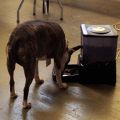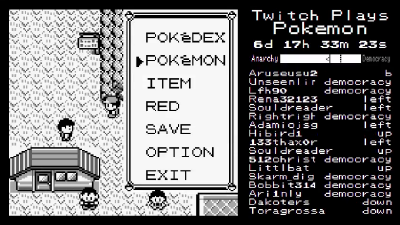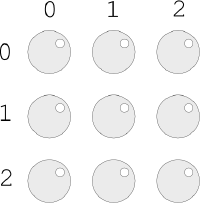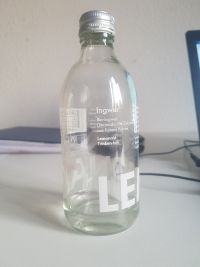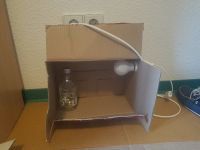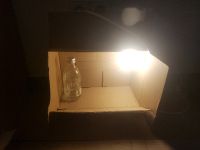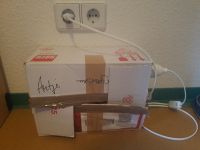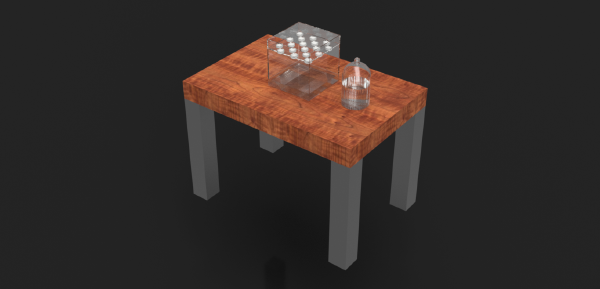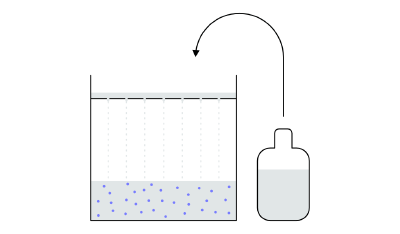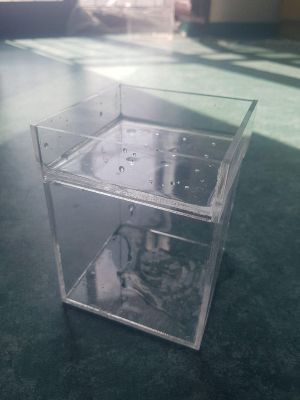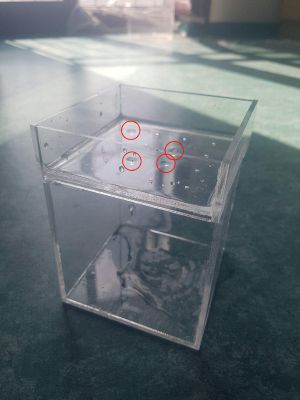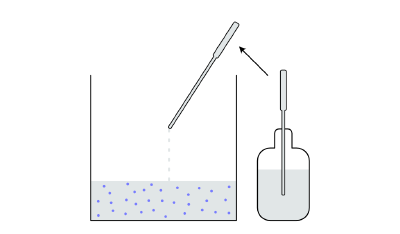Cesardaher (talk | contribs) No edit summary |
Cesardaher (talk | contribs) |
||
| Line 64: | Line 64: | ||
These commands were devised to navigate a 3x3 LED matrix in which the LEDs were stored in the code as a 2D array. That way, they were able to be lit up by calling their indexes. | These commands were devised to navigate a 3x3 LED matrix in which the LEDs were stored in the code as a 2D array. That way, they were able to be lit up by calling their indexes. | ||
[[File:LED_array.png]] | [[File:LED_array.png|200px]] | ||
=Development= | =Development= | ||
Revision as of 16:53, 5 March 2020
Twitter-Controlled LED Matrix
The concept
This project was created as an attempt to use Twitter API to send commands to a microcontroller. Its basic structure consists of a matrix of LEDs in which only one of them is lit up at a time. The Twitter API is used to collect information from tweets in order to choose which LED to light up.
At first, the idea was to collect and analyze information from tweets all around the world, so as to generate inputs. However, as this was my first time working with both microcontrollers and APIs, it was preferred to lower the complexity of this interaction to the level of generating inputs from individual tweets using the search feature.
Requirements
The following materials and services were used in order to develop this project:
- ESP8266 NodeMCU microcontroller;
- Elegoo UNO R3 Super Starter Kit (or similar, such as Arduino Uno);
- 9 LEDs;
- 9 resistors (220 Ohms);
- Jumper wires;
- Breadboard;
- Arduino software;
- Twitter API Library for Arduino;
- Twitter developer account;
The core of this project is the use of ESP8266 in order to connect to the internet and access the Twitter API. It is worth mentioning, though, that I was required to apply for a developer Twitter account in order to access the API.
References
In order to develop this project, most of my research was focused on tweet-to-microcontroller interactions on platforms such as Pinterest, Instructables and Hackaday. The two examples below are, respectively, Mood Lamp Based on Twitter Hashtags and Twitter-Controlled Pet Feeder. The former searches for the use of hashtags such as #angry in order to determine the color of the lamp, while the latter receives from a specific user tweets as direct commands to the pet feeder.
Another conceptual reference are the Twitch Plays Pokémon streams. In these game streams, a Pokémon game is run, being controlled entirely by commands given by the viewers on the chat. For example, if a person were to say "A+B" in the chat, this would be taken as an in-game command to press the A and B buttons at the same time. Though not a particularly optimal way to play the game, it is an interesting approach as how to create a cooperative multiplayer experience within a single-player game.
Development
The first attempts were to connect the ESP8266 to the internet and use it to access the Twitter API to retrieve tweets without issuing any additional commands. The Twitter API library for Arduino comes with three basic functions:
- Search for a keyword
std::string search_str;
String tmsg = tcr.searchTwitter(search_str);
- Retrieve user information
std::string search_str;
tcr.searchUser(search_str);
- Post to Twitter
std::string twitter_post_msg;
tcr.tweet(twitter_post_msg);
The first one was in the core of the project, while the second and third were only used for some early testing. In order to use the search feature, it is required to define a search string, which can be formatted to include complex parameters (explained in the Developer Twitter Documentation). This function, however, does not support tweet collection or analysis.
Once I understood how to properly use this library and had successful attempts, I moved on to develop a more complex mechanism. Inspired by the previously mentioned Twitch Plays Pokémon, I devised a device which would collect tweets with any one of the directional words "up", "down", "left" and "right" (excluding retweets, in order to prevent duplicates) and use them as commands for the microcontroller. The interesting thing about these words is that they are extensively used in the English language with other conotations, which makes the search especially random.
std::string search_str = "up OR down OR left OR right -RT";
These commands were devised to navigate a 3x3 LED matrix in which the LEDs were stored in the code as a 2D array. That way, they were able to be lit up by calling their indexes.
Development
Initial studies
My plan is to work with Pyrocystis Fusiformis, also know as Bioluminescent Algae to develop some sort of interactive media. In order to be able to have concrete ideas on which kinds of projects can be developed, I first need to learn how to grow and take care of them.
At first, I received a sample of algae from Antje Danz's stash. For that, we prepared a medium using the recipe provided by Frederic Blais-Belanger. At first, the algae were glowing very faintly in the dark, probably because they were not being given the proper care, so I also took on a caring method similar to Frederic's in order to grow them properly.
First, I put the medium with the algae inside an empty bottle I had at home.
Then, I built a simple system with a small cardboard box and a lightbulb that can be switched on and off.
They have been subject to a cycle of 12h light - 12h darkness. I still did not have the knowledge necessary to build a timer, so the activation and deactivation of the switch had to be done by hand, meaning that the cycle has had a few irregularities.
Concept development
My main interests when working with the dinoflagellates are memories from a trip I made once to a beach in Brazil. There, I was able to experience them while rubbing my feet on the wet sand. This inspired me to create a symbiotic space for humans and dinoflagellates, bringing forth the experience of the night coast as their original meeting environment. For this, I intend to work with three main elements: the sky, the sand and the sea.
The sky is the setting, it can be seen all around as a continuous dark surface that can't be interacted with. The sand is the entrance, but also the humans' natural space, where they can feel comfortable and safe. The sea is the destination, and the organisms' natural space. In between the sand and the sea, there is the wet sand, the ideal spot where humans and dinoflagellates can meet.
An important reference is the installation Tropicália by Brazilian artist Hélio Oiticica, realized in 1967 at the Museum of Modern Art, Rio de Janeiro. His work attempts to create a tropical, iconically Brazilian environment in which the people can be reminded of the experience of walking through the hills and favelas of Rio de Janeiro.
Summaery Proposal
- Complete: /Summaery 2019
The idea is to create a hidden environment that can be discovered by interacting with bioluminescent Algae. The project’s main object is a transparent tank filled with the algae in the appropriate medium, as part of a miniature artificial environment. The box will be placed inside a dark chamber so that when a person pours the appropriate medium on the box through a dripping mechanism, the algae will glow and reveal the inner environment.
The idea of dripping water on the tank comes mainly from the idea of rain as a natural phenomena that could familiar to both humans and algae. When the visitor pours medium on top of the population, they are also nourishing them with new nutrients, renewing their environment. It is also an attempt to interact with the algae in a more respectful and gentle way, unlike many installations that attempt to make them glow through unusual means, such as sound vibration. With this sort of interaction, the viewers can experience their beauty without disturbing them too much, and in a way in which they can glow for longer.
Execution
Some attempts to make a dripping mechanism on top of the aquarium were made. These prototypes featured a lid with small holes to make the water drip, instead of pouring. The idea here was to simulate rain, as the water would drip through many holes randomly, and slowly. The schematics below illustrate how people are supposed to interact with the tank. Inside the tank, there is an algae population; beside it, a bottle filled with the appropiate medium, without algae.
When testing it with a real model, instead of dripping through the many holes, though, the water would drip through only a few holes, in a fast pace. Another problem is that the mechanism on top would distract the view of the environment itself, as the surface was not visible from above.
Because of that, the whole project was simpliflied. The lid was replace by the usage of lab pipettes, used for dripping liquids onto containers in a controlled manner, as seen in the schematics below. This way, the viewers will have more restricted amounts of liquid to drip, but also more liberty to choose where in the tank they would like to do it.
References
TROPICÁLIA . In: ENCICLOPÉDIA Itaú Cultural de Arte e Cultura Brasileiras. São Paulo: Itaú Cultural, 2019. Available in: <http://enciclopedia.itaucultural.org.br/termo3741/tropicalia>.

